Caring for aloe.
Contents of
- What is aloe vera and agave, what is the difference between them, where is the origin of the plant origin?
- What pot and soil are needed for planting aloe vera, a century old?
- How to propagate, plant and grow aloe vera, the top of the century, from a shoot without a root, leaf and seeds?
- Is it possible to transplant aloe and centennial in autumn, in winter?
- What to do to make aloe flowered?
- What and how to feed agave, aloe vera in spring, summer, autumn, winter?
- Diseases of a flower of an aloe vera, an age - the ends of leaves turn yellow and dry up: what to do?
- The magical properties of aloe
- Video: Aloe care
The benefits of aloe are known for a long time, but not everyone knows in detail about its properties and scope of use. This will be discussed later.
What is aloe vera and agave, what is the difference between them, where is the birthplace of the plant origin?
Aloe is an excellent tool that helps relieve pain and speed up the healing process of cuts, and also cures chronic diseases. There are a lot of varieties of this plant. But the most common in our region are:
- Aloe vera( also called "centennial")
- Aloe vera
Aloe belongs to succulent plants that do not require copious watering. In winter, it should be watered no more often than once a month, in the summer a little more often.
IMPORTANT: There are no more than 500 species of plants that are mainly distributed in Africa and the Arabian Peninsula.
The healing properties of the plant:
- Pain relief and acceleration of healing of cuts
- Facilitates the course of broncho-pulmonary disease
- Reduces pain in stomach diseases
- Improves the situation with eye disease
- Aloe is indispensable in cosmetology for skin and hair
- The plant has many useful components that strengthenimmunity
 Useful properties of aloe
Useful properties of aloe Aloe is useful for both pulp and juice. For the pulp, the lower thick leaves are suitable. When the tip of the leaf began to dry out a little, it means that the plant gave the maximum proportion of useful substances and the leaf is ready for use.
To use the pulp it is necessary to put the sheet in the refrigerator for several days and, after washing with boiled water, remove the skin. Now the flesh can be used.
Aglet is most often used for external use, namely for:
- Wound healing and reconstitution
- Dermatitis consolidation
- Healing of boils
- Accelerating tissue regeneration with burn or frostbite
- Varicose veins relief
- Skin moisturizing
- Reducing wrinkles
- Reducing itching with an insect bite
- Strengthening hair, rid of dandruff
- Smoothing of post-operative scars
Aloe vera is also used for internal use, namely:
- Strengthening the immunity
- Stabilizing the blood sugar
- Preventing digestive disorders
- Strengthening the heart muscle
- Gum problem solutions
- Reducing inflammation in arthritis
- Improving the genitourinary system
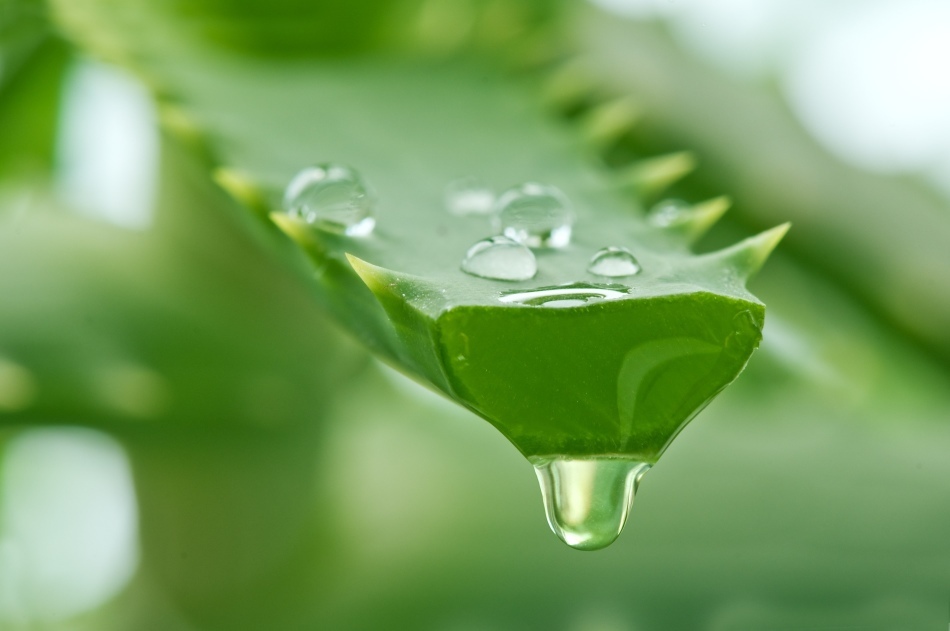 The healing properties of the aloe
The healing properties of the aloe But there are contraindications for the application of both plants. So:
- Aloe vera can not be used by people with low blood sugar, since this plant can lower the figure even more.
- People who have experienced spasm of blood vessels should also carefully approach the use of the plant. Since aloe leads to the fact that the vessels become even wider.
- It is also not advisable to take aloe with pregnant women. The risk of bleeding is not ruled out.
- Agave is banned in oncology, as it promotes the growth of cells in the body and it is possible that it is the cancer cells that will multiply when using the plant.
- With purulent wounds, it is necessary to remove pus first, and then use a century-old. Since the top of the skin will heal, and pus inside and remain.
What pot and soil are needed for planting aloe vera, an age-old?
Planting or transplanting any of the aloe species is desirable in the spring. It is during this period that vegetation begins, and the plant has already blossomed during transplantation.
The plant you plant for the first time will need to replant after a year. More mature plants are transplanted every 2-3 years, depending on the growth of aloe.
To determine whether a transplant is necessary to a plant is very simple: if you take aloe from a pot and see that the roots are densely intertwined, and there is no mail land, it means that the plant needs to be transplanted urgently.
Pots are mainly made of plastic or clay. And in this and that variant there are advantages and disadvantages:
- Plastic pots are light and cheap. But because of their lightness, they become unstable and easily crack.
- Roots in plastic pots are located more evenly and make holes easier.
- In clay pots, moisture evaporates faster, so it will be necessary to water the aloe more often.
- Clay pots keep the temperature required for the plant well, so the aloe will be protected from overheating. In such pots, plants can even be planted in the ground for the summer.
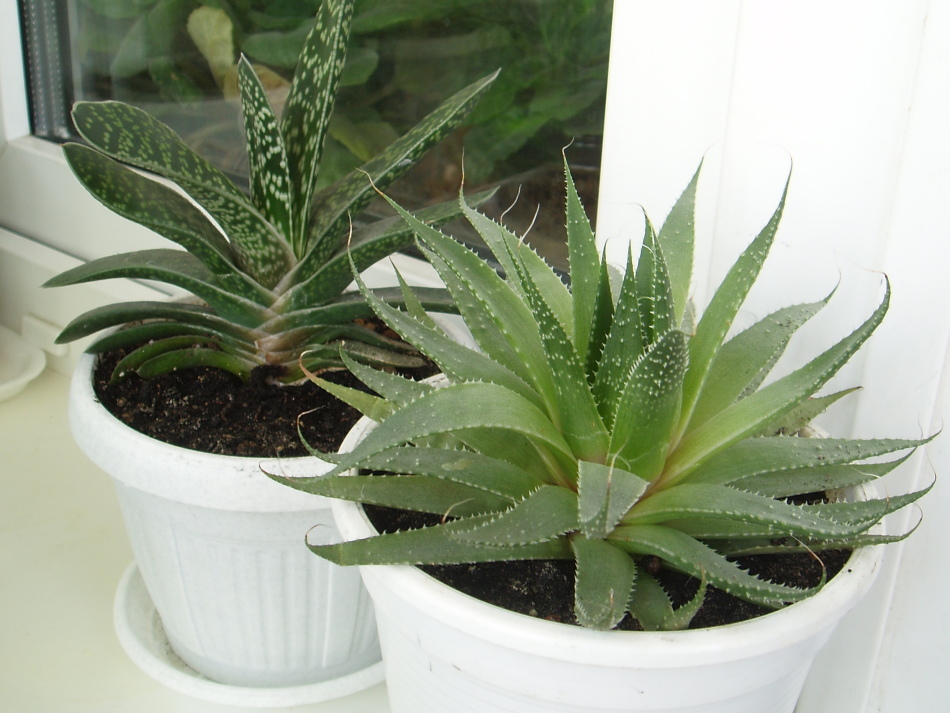 Aloe pot
Aloe pot If you saw during the transplantation that the root system is wide, then you need to take a larger pot in the diameter. Growing deep into the vessel, the roots require a taller pot.
IMPORTANT: The size of the aloe pot should match the size of the root system. In the bottom of the pot there must be holes for draining the liquid.
If you transplant plants into large pots, and in the former plant a new scarlet, then the plastic container should be thoroughly washed with hot soapy water and the clay warmed in the oven. So you prevent a possible attack of pests on new residents.
Now we turn to the question of soil for a plant. For an aloe an ideal variant will be a combination of a turf and charcoal, and also sand and humus in equal parts.
A day before transplanting or planting the plant should be carefully poured. Then loosen the ground from the above ingredients and gently place the aloe in the pot. Make sure that the root neck is a few centimeters above the poured soil. The earth needs to be thoroughly trampled and watered.
 Growing Aloe
Growing Aloe When you plant or transplant a flower, you need to put it in a dark place and do not water for several days. If there is a surplus of moisture in the pot, this can lead to decay of the roots.
How to propagate, plant and grow aloe vera, the top century, from the shoot without a root, leaf and seeds?
You can propagate aloe in many ways. Let's look at each of them. The first way is cuttings. This way, reproduction is possible all year round, but it is better to still carry out the process of reproduction in the summer.
Cuttings are located on the sides of the stem of the plant. The breeding process is as follows:
- Cut the stem at the base and dry for 5 days in a dark place.
- Place cut with charred charcoal.
- Plant the cuttings after 5 days in moist sand at a distance of 5 cm from each other to a depth of 1 cm.
- Moisten slightly the sand regularly, and when the first roots appear, increase the watering.
- After 7 days, plant the cuttings in pots.
- Mixture for young plants should be selected in the same way as indicated earlier.
 Cutting
Cutting You can also multiply aloe with a sheet. For this:
- Cut or pinch the leaf at the base and place it in a dark place.
- Keep it there until the place of the cut is dry.
- Plant the leaf in sandy soil to a depth of 3 cm and water regularly until you see the sprouts.
You can propagate aloe, if you use shoots, that is, plant children. It's very easy to do this. It is only necessary to carefully dig out the young plants and transplant them into a separate pot with soil in which the sand mixture exceeds.
Propagation of aloe is also carried out when using seeds. This is a rather labor-intensive occupation, for which it will be necessary to plant the seeds at the end of winter at room temperature. We need to monitor the regular irrigation and soil quality. It should consist of sand, turf and leaf land in equal parts.
After seedlings seedlings need to be transplanted into small boxes with the same soil composition. When the plants are already strong enough, they can be planted in pots.
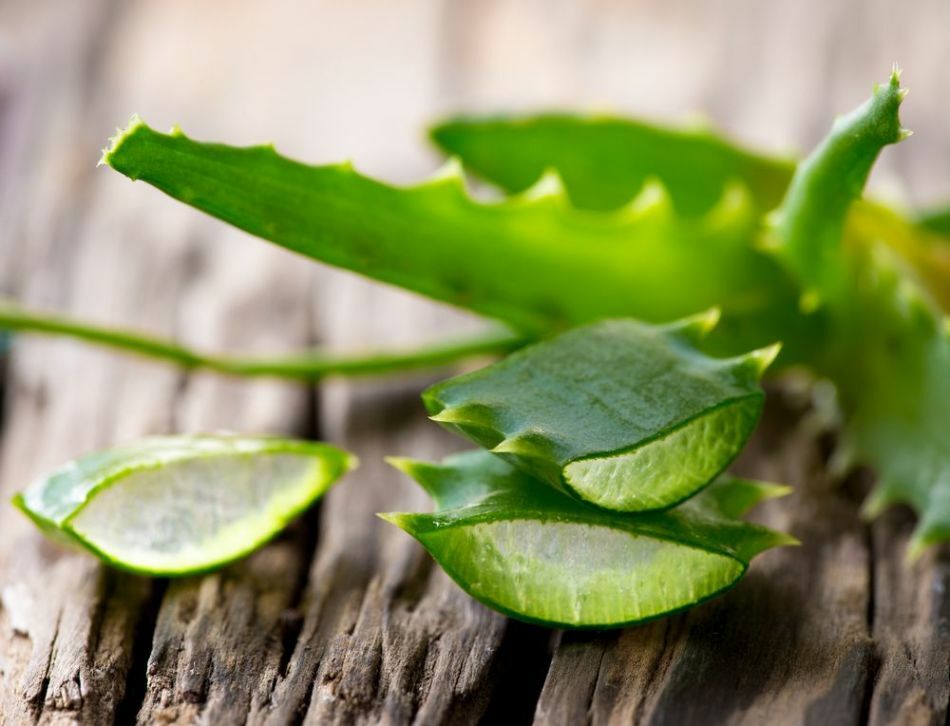 Reproduction by leaf
Reproduction by leaf The last method is the multiplication of plants by the apex. In this case, you need a tip of aloe with 7 leaves, which you need to put in a jar of water. After the plant takes root, it must be transplanted into a pot.
Is it possible to transplant aloe and centennial in autumn, in winter?
Transplant and multiply aloe should only be in the warm season. Summer and late spring are perfect for this. In winter and autumn, it is strictly forbidden.
What to do to make aloe flowered?
Flowering of aloe - this is a very rare event, because even in the greenhouse this process takes place once in twenty years. And then, only special conditions are needed. And at home, the flowering of plants is almost impossible to see.
During flowering, aloe vera grows from 30 to 80 cm of flower stems, on which there are large inflorescences of tubular flowers. Different kinds of flowers have different colors.
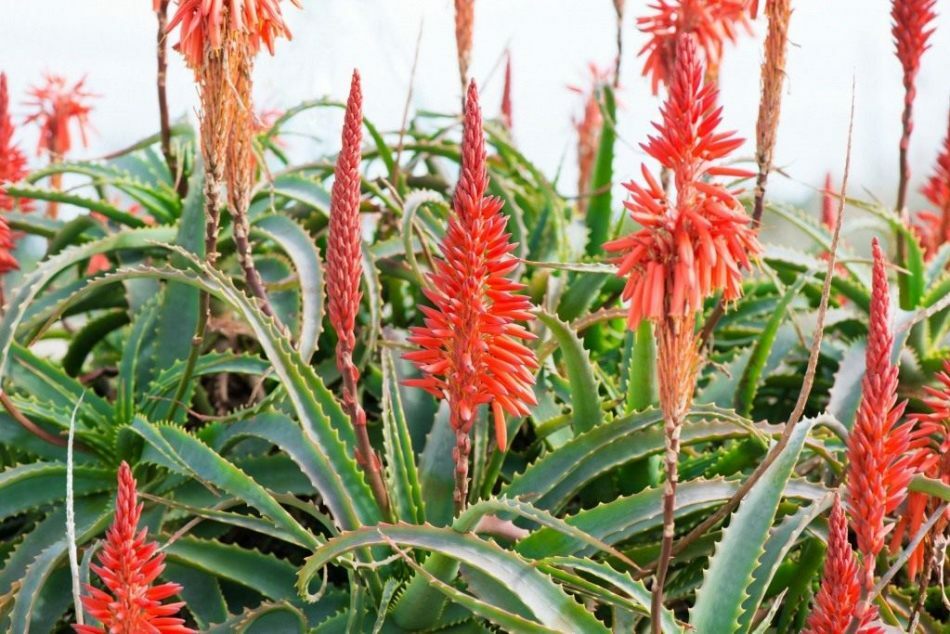 Aloe vera blossom
Aloe vera blossom If you are still determined to see aloe blossom at home, you need to wait until the plant turns 10 years old. Choose for preparation the winter period, because the plant needs a period of rest before an important event.
- The temperature in which the aloe will be located should be low( 10-14 degrees).But in the room you need to install additional lighting to extend the light day.
- Maintain dry indoor air to prevent rotting roots.
- For irrigation use a drip tray, which will immerse the pot with the plant for 10 minutes.
Under such conditions it is quite possible to see the flowering of the plant. The aloe flower has a very strong smell due to the large amount of nectar.
IMPORTANT: You can not stay in a closed room with a flowering plant for a long time, since you can feel a strong headache.
When aloe blossoms, the temperature can be raised by 10 degrees, but the light should be in the room with the flower as long as possible. If aloe grows for more than 20 years, but does not bloom, then the conditions for it are not suitable. In a state of rest, the plant can always be, so it is called the century.
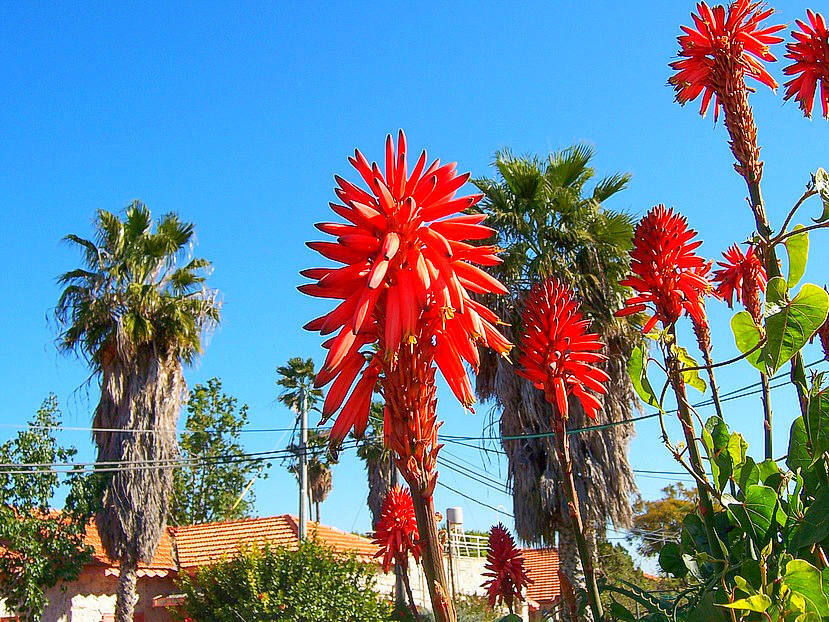 Brightly flowering aloe
Brightly flowering aloe In places of origin, aloe blossoms 1-2 times a year. Most often the plant blooms once a year for 6 months, from the beginning of spring to the beginning of autumn.
How and how to feed a century-old, aloe vera in spring, summer, autumn, winter?
When the aloe grows it needs to be fed 2 times a month. Choose plants that fertilize cacti and succulents.
- Use liquid mineral fertilizer, but make sure that the drops do not fall on the leaves of the aloe.
- With the advent of summer, the plant needs to be fertilized also twice a week with an integrated fertilizer for cacti. This helps to stimulate growth and improve the overall condition of the plant.
- Before fertilizing the plant, you need to thoroughly moisten the soil. Since excessive concentration of salts can adversely affect the plant without pre-irrigation. Therefore, only when the soil is moist can fertilizer be used.
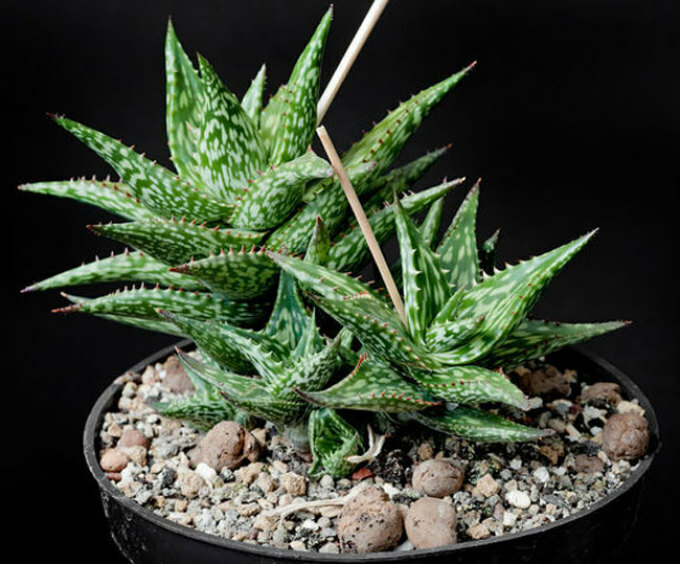 Aloe Vera
Aloe Vera - If you just bought aloe, then you need to use the fertilizer a month after planting. When the plant grows at home, the fertilizer is carried out after the appearance of the shoots.
- After the first feeding of young aloe, the next one should be carried out not earlier than in half a year.
- If you planted young aloe in a special soil for cacti or succulents, then fertilizing for 8-9 months is not required.
- Application of fertilizing is carried out only on a healthy plant, a sick flower is necessary for beginning to be cured.
Diseases of a flower of an aloe vera, an age - the ends of leaves turn yellow and dry up: what to do?
Aloe is most often affected by root and dry rot. Let's look at each of these diseases in more detail:
- Roots rot with abundant and frequent watering. If you diagnose the disease in time, you can save the plant.
- If you see that aloe does not grow and the stem shrinks, then most likely the plant is sick.
- Check the roots and remove the decayed parts. Fill the remaining roots with the powder from the coal, and plant in fresh soil, with a significant predominance of sand.
- Restart irrigation only after 3 weeks.
- Plant with completely rotten roots should be propagated by cuttings. Make sure that the cut piece is healthy.
- A completely damaged plant that did not manage to be salvaged should be discarded with the pot and soil.
dry rot affects plants that are contained in the wrong place. Aloe in this case very quickly begins to dry out. There is no fight in this case, since the process of destruction of the plant occurs very quickly.
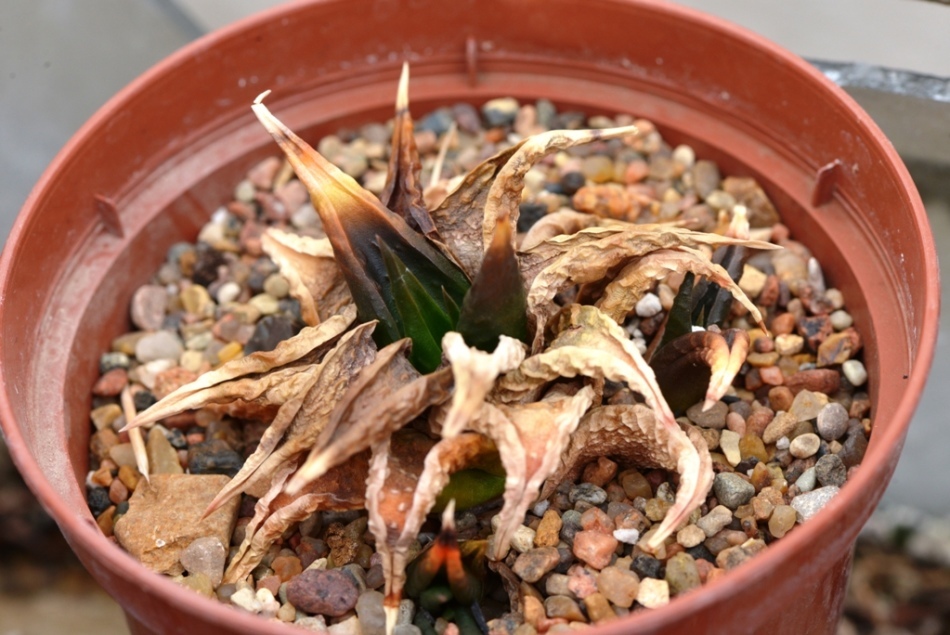 Aloe vera diseases
Aloe vera diseases It also happens that the aloe leaves turn yellow. In this case, we can talk about this reason:
- The plant became crowded in the pot in which the aloe grows. The aloe root system develops quite quickly. Therefore, drying leaves of aloe indicates the need for a transplant.
- Excessive watering. Aloe should not be poured. And if you saw yellow leaves, and the plant was transplanted only recently, then you should dig the ground and get to the root. If in the soil or on the roots you have noticed rot, then this can be the reason for changing the color of the leaves.
- Incorrect placement. Aloe is extremely unpretentious, but still needs enough light.
IMPORTANT: To return the former bright light to the leaves of aloe, carefully observe the place in which you have identified the pot with the plant, as well as the amount of watering. Do not overfeed the plant with fertilizer too. Since an overabundance of components can lead to yellowing leaves and weakening of the stem and root of the plant.
Approach care for aloe vera carefully and do not overdo it with care. Then you can admire the rich color and powerful leaves of the plant.
Magical properties of aloe
Finally, let's talk about the magical properties of this plant. If someone does not know, then, perhaps, after reading this information, immediately go to the flower shop of aloe. For those who have a plant at home, it will be useful to find out about their plant interesting information. And also it is necessary to observe, probably, any magic signs already exist and at you at home.
- Aloe is the protector of the house and its inhabitants from an accident.
- In the places of origin of the plant, its leaves hang over the front door, as protection against troubles and attracting luck.
- Ancient Egyptians brought leaves as gifts to the gods, as a curative remedy.
- In Western Europe hundreds of years ago, the century was considered a plant that brings love and faith in the heart.
- According to bioenergetics, aloe in the house with the sick has a special value. After all, in this case, the plant is the purifier of the aura.
- To protect yourself from the evil eye, hang the dried aloe leaf over the front door.
- From the roots of aloe, talismans were made. To do this, they were dried, put in a bag and hung around the neck or hidden in an inner pocket.
- The plant was used to attract grooms and love. Drying of 13 leaves was burned for 13 days and developed ash in front of the house. But it is important to sincerely ask for forgiveness from the plant while tearing the leaves.
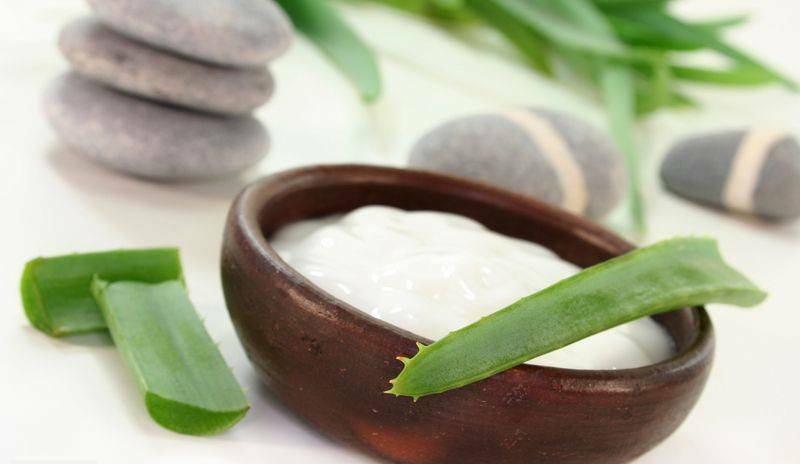 The magical properties of aloe
The magical properties of aloe If you have blossomed aloe, it means that you and your family will soon be lucky and happy. So let each of us at least once a year this plant blooms.
